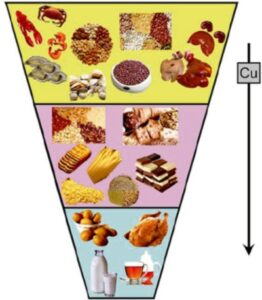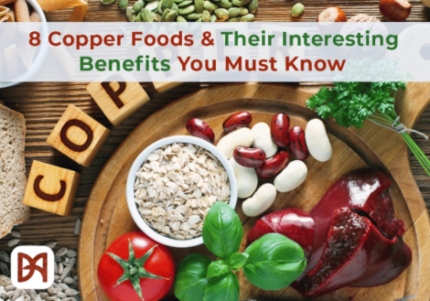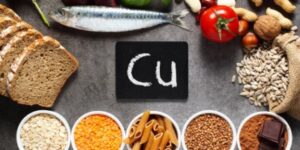Plant- and animal-based foods can both be considered copper foods. This may relate to oysters and leafy vegetables. To find out the best copper food list, continue reading.
Table of Contents
ToggleBest Copper Foods
Your body needs small amounts of the mineral copper to be healthy. And it can be obtained from copper foods only.
Copper is necessary for the formation of red blood cells, bone marrow, fibrous tissue, and a few key enzymes.
Additionally, copper is necessary for the immune system to operate properly, for the digestion of cholesterol, and the nurture and development of unborn children. It is an important mineral, meaning that even though your body cannot create it on its own, you must get it from your food even if you only require very small amounts of it.
Adults should consume 900 micrograms of copper daily. But you should take slightly more—1 mg or 1.3 mg daily, respectively—if you’re pregnant or nursing.
Here are High Copper Foods.
Copper Food List
Here is the ultimate copper food list (Copper Food Sources) for you.
Liver
Organ meats like the liver are packed with nutrients. They offer a good amount of vitamins and minerals, including vitamin B12, vitamin A, riboflavin (B2), folate (B9), iron, and choline. The liver is also a great source of copper.
Just one slice (67 grams) of calf liver contains 10.3 mg of copper, which is an impressive 1,144% of the recommended daily intake.
To enhance the flavor of liver, you can pan-fry it with onions or blend it into burger patties and stews. However, pregnant women should avoid liver and other foods that are extremely high in vitamin A, as too much of this vitamin can be harmful to unborn babies.
Oysters
Oysters, a type of shellfish, are often seen as a delicacy and can be enjoyed either cooked or raw, depending on your taste. They’re low in calories but packed with essential nutrients like zinc, selenium, and vitamin B12.
A 3.5-ounce (100-gram) serving of oysters provides an impressive 7.6 mg of copper, which is 844% of the recommended daily intake.
Some people worry about the cholesterol in oysters and other shellfish.
However, for most people, the dietary cholesterol in foods like oysters won’t have a big impact on their blood cholesterol levels unless they have a rare genetic condition. One thing to be mindful of is that oysters are also extremely high in zinc—154 mg per 100 grams.
Since high levels of zinc can interfere with how your body absorbs copper, this could affect the amount of copper you get from oysters.
Additionally, raw oysters can carry a risk of food poisoning, so it’s best for pregnant women and those with weakened immune systems to avoid them.
Spirulina
Spirulina is a powdered food supplement made from blue-green algae called cyanobacteria. It was once eaten by the ancient Aztecs and became popular again after NASA used it as a dietary supplement for astronauts during space missions.
This tiny supplement is packed with nutrients. Just one tablespoon (7 grams) has only 20 calories but delivers 4 grams of protein.
It also provides 25% of your daily need for vitamin B2 (riboflavin), 17% for vitamin B1 (thiamine), and around 11% for iron. Plus, the same amount gives you 44% of your daily copper requirement.
Many people mix spirulina with water to make a green drink, but if you’re not a fan of its unique taste, you can easily hide it in soups, smoothies, or cereal.
Shiitake Mushrooms
East Asian native shiitakes are a species of edible fungus with a strong umami taste.
15.4 grams of dehydrated shiitake mushrooms provide 2 grams of fiber, 44 calories, and a plethora of minerals, such as zinc, selenium, manganese, folate, and vitamins B1, B5, B6, and D.
Additionally, this section eliminates an astounding 89% of the copper RDI. It is one of the top Copper Food Sources.
Nuts and Seeds
Nuts and seeds are little nutritional powerhouses. Along with being rich in many other nutrients, they are also abundant in fiber, protein, and healthy fats.
While the nutrients in nuts and seeds vary, several of them include significant levels of copper.
Almonds and cashews, for instance, each contain 33% and 67% of the RDI in only one ounce (28 grams).
Sesame seeds, which contain nine grams in one tablespoon, also provide 44% of the RDI. Nuts and seeds can be eaten on their own as a snack, on top of a salad, or cooked into bread or casseroles.
Lobster
Large, powerful crustaceans that reside on the ocean floor are called lobsters. They may be eaten on their own, but their luscious flesh renders them a favorite inclusion in bisques and soups.
Vitamin B12 and selenium are only two of the many vitamins and minerals found in lobster flesh, which are also high in protein and low in fat.
It’s a great place to get copper as well. A mere 3-ounce (85-gram) portion of lobster, for instance, provides an astounding 178% of the RDI.
Fascinatingly, lobster has a rather high cholesterol content while being low in fat. The quantity of lobster shouldn’t be a problem, though, as most people’s blood cholesterol levels are not significantly affected by dietary cholesterol.
Leafy Greens
Leafy greens like spinach, kale, and Swiss chard are packed with nutrients such as fiber, vitamin K, calcium, magnesium, and folate, all while being low in calories. Many of these greens are also rich in copper.
For example, one cup (173 grams) of cooked Swiss chard contains 33% of the recommended daily intake of copper. Similarly, one cup (180 grams) of cooked spinach provides the same amount.
You can enjoy these greens raw in salads, cooked in stews, or served as a nutritious side dish to boost both your copper intake and overall nutrition.

Dark Chocolate
Dark chocolate has more cocoa solids and less milk and sugar than regular chocolate. It’s rich in antioxidants, fiber, and key nutrients.
For instance, a 100-gram (3.5-ounce) bar of dark chocolate with 70–85% cocoa contains 11 grams of fiber, 98% of your daily need for manganese, and 67% of your daily iron requirement. It also provides 200% of your daily copper intake. Including dark chocolate in a balanced diet can help improve several heart disease risk factors.
Are High Copper Foods Good?
Your diet should contain a variety of foods (including copper foods), containing meat and vegetables, as copper is essential to good health. So you should sometimes focus on High Copper Foods.
Oysters, nuts, seeds, shiitake mushrooms, lobsters, liver, green leafy vegetables, and dark chocolate are some particularly excellent sources. Make sure your diet contains a range of these sources to prevent a deficit.





